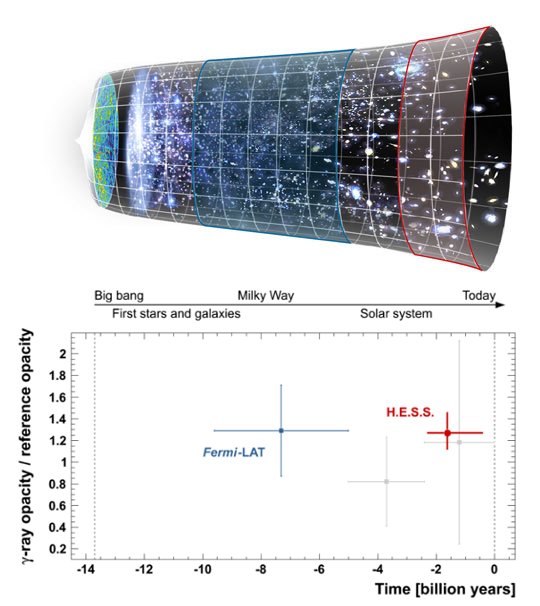Using some of the brightest gamma-ray sources in the southern hemisphere, researchers from the Laboratoire Leprince-Ringuet (CNRS/École Polytechnique) have carried out the first measurement of the intensity of the diffuse extragalactic background light in the nearby Universe, a fog of photons that has existed since its formation.
The study was carried out using measurements performed by the HESS(1) telescope array, located in Namibia and involving CNRS and CEA. The study is complementary to that recently carried out by the Fermi-LAT(2) space observatory.
The light emitted by all the objects in the Universe (stars, galaxies, etc) ever since its birth fills intergalactic space with an 'ocean' of photons known as the 'diffuse extragalactic background light'. The ambient luminosity of our own Galaxy makes it impossible to directly measure this fossil record of the light emitted in the Universe. To get around this problem, astrophysicists make use of gamma rays (3) (whose energy is more than 500 billion times greater than that of visible light), which provide an alternative, indirect method of measuring this light.
A beam of gamma rays emitted by a distant galaxy located several hundred million light years away is attenuated on its way to Earth due to interactions with diffuse light. More specifically, when a gamma-ray photon enters into contact with a diffuse photon it may 'disappear', giving rise to an electron and its antiparticle, a positron, which reduces the intensity of the beam.
The thicker the fog of diffuse photons, the greater the attenuation, and the smaller the size of the Universe observable in gamma rays. Finally, absorption by the Earth's atmosphere of the remaining radiation gives rise to a shower of subatomic particles, which generates a flash of light that can be detected from the ground by the HESS telescope array. HESS detects very-high-energy gamma rays (in the region of a thousand billion eV), while those with lower energy are directly detected by the Large Area Telescope (LAT) on the Fermi Gamma-Ray Space Telescope.
These findings provide new insight into the size of the Universe observable in gamma rays and shed light on the formation of stars and the evolution of galaxies.

The vertical axis of the graph shows opacity normalized to a reference model (Franceschini et al., 2008), while the horizontal axis shows the distances in light years of the blazars used for the measurements. The blue point on the left shows the range within which the Fermi measurements are statistically significant, and the red point on the right shows the measurements carried out by HESS in the nearby Universe. © HESS Collaboration
In this study, the researchers focused on distinctive galaxies called blazars (4), which are several billion light years away. By using HESS to measure the gamma-ray spectra emitted by relatively close blazars, they evaluated the effect of the interaction of highly energetic gamma rays with the diffuse extragalactic background light within a sphere of a three billion light year radius. The Fermi-LAT collaboration did the same for the more distant Universe, from 5 to 10 billion light years away. These measurements made it possible to estimate, for the first time with a precision of around 20%, the intensity of the starlight contained within the Universe at wavelengths ranging from the near infrared to the ultraviolet, including visible wavelengths.
A better understanding of this diffuse light, which acts as a record of the Luminous Universe, provides information about the first stars, shedding light on their formation and on the evolution of galaxies. This new data could be incorporated into certain cosmological models to better describe the rate and processes of star formation since the birth of the Universe.
These findings can also be used to define the size of the Universe observable in gamma rays, and open up the possibility of studying the signatures of more fundamental mechanisms related to intergalactic magnetic fields, as well as exotic physical phenomena.
NOTES:
(1) H.E.S.S.: 'High Energy Stereoscopic System'. The international HESS collaboration currently brings together 180 researchers from 28 laboratories in 12 different countries, mainly in Germany and France.
(2) The Imprint of the Extragalactic Background Light in the Gamma-Ray Spectra of Blazars. Ackermann et al., Science, published online on 1 November 2012 and in print 30 November 2012 (Vol. 338 no. 6111 pp. 1190-1192). 10.1126/science.1227160.
(3) Gamma radiation is made up of photons, just like visible light or X-rays, but it has far higher energy.
(4) Blazar: galaxy at the center of which gamma rays shine brightly, due to black holes, and whose jets of particles are pointed towards the Earth.
Reference: Measurement of the extragalactic background light imprint on the spectra of the brightest blazars observed with H.E.S.S.. Collaboration HESS. Astronomy & Astrophysics, online 16 January 2013.